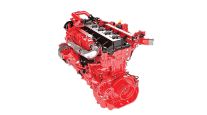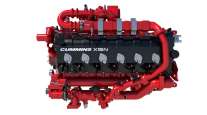Clean Energy, GE Form Partnership, To Build Pair of ‘Micro’ LNG Plants
This story appears in the Nov. 19 print edition of Transport Topics.
Clean Energy Fuels Corp. said it will purchase two liquefied natural gas plants from General Electric Co. as part of a new partnership between the two companies to develop LNG fueling infrastructure for the trucking industry, the firms announced last week.
Clean Energy, which is building a national network of LNG fueling stations, will purchase the two “micro” LNG plants from GE Oil & Gas with the help of $200 million in financing from GE Energy Financial Services, according to the Nov. 13 announcement.
In return for favorable terms on the loan, Clean Energy said it will offer GE the right to purchase up to 5 million shares of its stock at 1 cent per share by the time that both plants are constructed and financed.
The full stock purchase would represent about 5% ownership in Clean Energy, a company spokesman said.
Clean Energy CEO Andrew Littlefair described the agreement with GE as “one of the most significant milestones in Clean Energy’s history.”
“GE partnering with Clean Energy on these two facilities will not only help ensure an adequate LNG supply for our stations, but it is another confirmation that the transition to natural gas as a transportation fuel is gaining momentum,” Littlefair said in the announcement.
In a conference call, he said GE and Clean Energy have structured their agreement to provide the option and flexibility to collaborate on additional LNG plants in the future, beyond the two spelled out in the deal.
“We’ve always thrown around the notion that we would like to be thinking as a team — a GE, Clean Energy team — that these are the first of 10 or so,” Littlefair said. “We’ve tried to structure our relationship to give us that flexibility.”
Mike Hosford, general manager for unconventional resources at GE Oil & Gas, described the relationship between the two companies in similar terms.
“We look at this relationship with Clean Energy not as a supplier-customer-type relationship but truly a partnership in terms of trying to develop the infrastructure in the United States around natural gas,” he said on the call.
GE and Clean Energy said they are currently assessing the best locations for the first two LNG plants, which they aim to make operational in 2015.
“We haven’t made formal an-nouncements yet, but I think you can figure one of them is going to be in the upper Midwest and the other in the Northeast,” Littlefair said on the conference call. “You can cover a lot of territory in those two locations, and then, of course, as we move forward, we’ll build others in other areas.”
Each of the two plants will produce as many as 250,000 gallons of LNG per day and will be designed for expansion up to 1 million gallons per day as adoption grows.
The LNG produced by the plants will be used primarily at Pilot Flying J truck stops across the country, the companies said.
Littlefair said that he expects natural-gas adoption in the trucking industry to mirror that in trash collection vehicles.
In 2008, following the introduction of Cummins Westport’s 9-liter natural-gas engine, about 3% of new trash-truck purchases in the United States were natural-gas trucks, Littlefair said. “This year, it was something closer to 55%, and next year it looks to be something like 65%,” he added.
With Cummins Westport set to introduce a 12-liter natural-gas engine in 2013, trucking companies will soon have access to the engine size that most of them want, Littlefair said.
“When that comes to market, I think you’ll begin to see the same exact adoption rate that you did for refuse, so 2013 will be a year of testing, but then you’ll begin to see the numbers move up,” he said. “If we’re really saving people $1.50 per gallon, which we are, and the engines work as I think they will, and you have the torque and horsepower that they require . . . I think you’re going to need 5 to 6 billion gallons of LNG here in the next six or seven years. In that case, you’re going to need dozens of these [LNG] plants.”
FedEx Freight, the less-than-truckload division of FedEx Corp., recently began testing two Class 8 trucks with preproduction 12-liter Cummins Westport engines in its regular linehaul operations (11-12, p. 15).
Clean Energy said it expects to complete about 70 LNG stations along major U.S. transportation corridors by the end of 2012, with more planned for 2013, as it develops its coast-to-coast, border-to-border fueling network.
Littlefair said Clean Energy currently owns two LNG plants, one in Texas and one in California, and also takes all of the product from a third plant in Arizona and has supply agreements with 13 other plants across the country.




